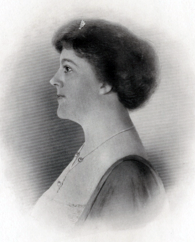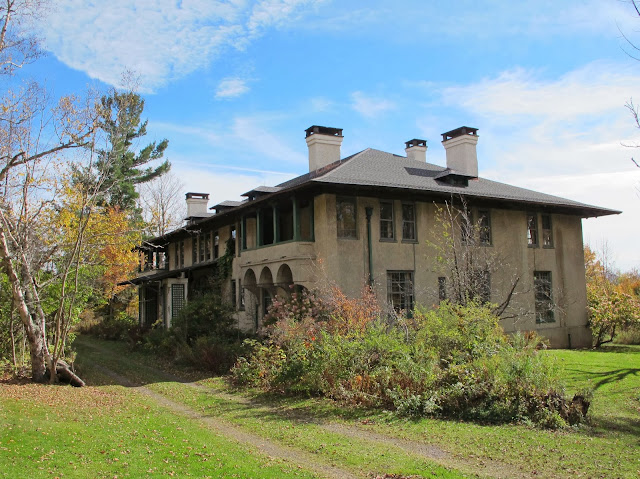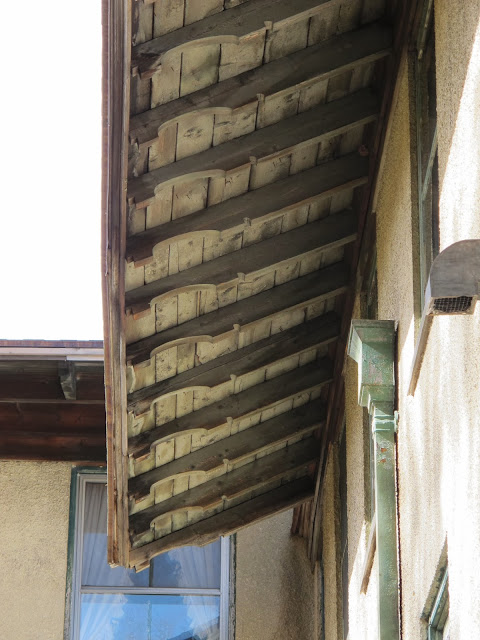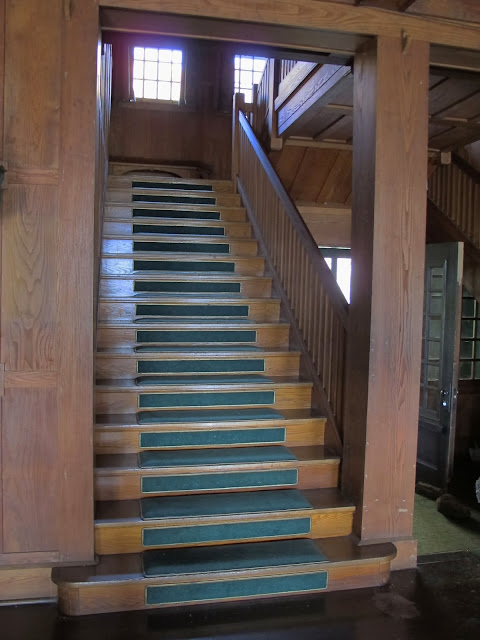People give their houses an infinity of odd names. A cursory internet search produces examples like Apple Drop, Beatle Fields, Clover Stump, Dingle Dell, Creeping Snails, Old Wob, Pratty Flowers and Frosty Cottage, the latter an good alternate for my own, what with November approaching.
I suppose there's nothing that unusual about Hathaway, the name attached to a large, Delano & Aldrich designed, Catskill Mountain summer house on the outskirts of Onteora Park, NY. Local legend attributes its construction (or construction of the wall in front of it, depending on the version you hear) to a spoiled wife. Offered the choice of a European tour or a big summer house (or a wall in front of it) the wife chose the tour. She then secretly had the house (or the wall) built while she and her husband were away. Presented upon arrival home with a fait accompli, the indulgent husband described his wife as a woman who always "hath her way." (Get it? 'Hath her way'...'Hathaway?') I've spent enough time around rich people to say with authority that if there's one thing they pay very close attention to, it's their money. I don't know if this story is charming or simply ridiculous. It may contain a kernel of truth somewhere, but one kernel is probably the extent.
V. Everit Macy (1871-1930), seen in the image below, was what my late father would have called "a helluva nice guy." He earned a degree in 1893 from Columbia's School of Architcture, where he studied alongside Chester Aldrich, architect of his future house. Macy himself never practiced professionally. Instead, this amazingly busy and selfless man spent his entire adult life improving the lives of others, mainly in Westchester County. He was commissioner of Charities and Correction, then of Public Welfare, and at the time of his death Commissioner of Parks. Macy also owned the Yonkers Statesman in the north, where he published his progressive opinions, and supported Tuskegee and Hampton Institutes in the south. As Parks Commissioner he was the organizing force behind two of Westchester's most recognizable features, the Hutchinson and Saw Mill River Parkways. It helped that he was rich, far more so than his collateral relatives, the department store Macys. The money came from the family oil business which, thanks to the efforts of Macy's father, was rolled into John D. Rockefeller's Standard Oil in the 1870s, to the great benefit of the Macy family.
Mrs. Macy, the former Edith Carpenter, gave her husband two sons, ran his households in Manhattan, Briarcliff Manor and Onteora Park, and spent her obligatory charity efforts on the Girl Scouts of America. From 1919 until her death in 1925, she chaired GSA's Board of Directors. You like Girl Scout cookies? Thank Mrs. Macy; her gift to us all is the annual cookie drive.
The Macys weren't a long-lived group. Everit Macy's father died at age 38; he himself succumbed unexpectedly at age 59 to pneumonia, while visiting the Ingleside Inn in Phoenix, AZ. County leaders, Supreme Court justices and lifelong friends like John D. Rockefeller Jr. joined Macy's sons and their wives for the funeral at Chilmark, the family estate at Briarcliff Manor (or actually Ossining, if you want to split hairs). In 1932 Westchester County named a 200-acre tract in the Town of Greenburgh "V. Everit Macy Park" in his honor. If you live in Westchester and thought that name came from the department store, consider yourself corrected.
Hathaway remained in the family, carefully maintained, through most of the Depression, but in 1938 it was finally put on the market. This was a better year than 1930 to try and sell a big house, but not by much. The Macy estate made a yeoman's effort to sell, as evidenced by the sale promotion literature. However, due to a scarcity of interested buyers, they put it up for auction in 1940.
At the auction, a pair of modest city types named Isadore Malvin and Max Reizen bid $12,500 for house, furniture, outbuildings and almost 600 acres of land - an won. After renting the place out for a season (interestingly, to a doctor who became President Nixon's psychiatrist), Reizen and his brother-in-law Sam Davis opened the Hathaway Lodge. A house containing 8 to 12 bedrooms (depending how you count them) plus another 12 servants' rooms would seem ideally suited for a career as a small Catskill Mountain Resort. From 1941 until the mid-1960s the Hathaway Lodge was a junior version of "Dirty Dancing." It advertised the usual golf, tennis, ping pong, horseback riding, swimming and "Super American-Jewish Cooking."
By the mid-Sixties, Catskill Mountain resorts were in economic freefall. In 1965, Annabeth and Mansfield Showers bought the by then already empty Hathaway Lodge for $39,000, moved in, and reopened it as a bed and breakfast. According to their brochure, "The Hathaway Inn offers Gracious Living for Adults" and "Daily rates without meals begin at eighteen dollars." The Showers converted the carriage house into the Snowdrop Chalet, where $15 bought you two nights in a dorm. For those who slept together, the cost was $19 for the same two-nights in a private Chalet room.
Here's what all the shootin's about, Hathaway, as it appears in the fall of 2013.
Hathaway, in the words of my friend, "New York Times" columnist Christopher Gray, "settles down into the hillside like a Great Dane getting ready for a nap." A big dog, I'd say, and one that's suffered more than a few kicks. Hathaway's not-so-vaguely Arts and Crafts design is a departure from the high style, uber-elegant Georgian Revival flash of so much of Delano and Aldrich's other work (think Knickerbocker or Colony Clubs, or grand Long Island mansions). It was, of course, an early contract, the firm being barely a year old when Macy hired them, probably because he'd gone to school with Aldrich. Hathaway's low to the ground architecture, its general Japanesey air, and unadorned pebbledash stucco exterior is said to be an homage to its owner's desire for Quaker-like simplicity. Personally, I find it hard to credit a man with a 20-room apartment at 845 Park Avenue, a 250-acre estate in Briarcliff Manor, and 12 servants' rooms in his Onteora summer place as being too big on "simplicity."
A sight we see on many a big old house (including my own); a beautiful copper leader "sans" connection to the gutter above which, we may also mention, is missing as well.
Hathaway is in remarkably unaltered condition - with certain exceptions. Prime among these is an awful wooden deck grafted onto the mountain view facade. This looks to be a product of the late Sixties or early Seventies, I can't tell for sure. Fortunately, deck, porch enclosure, and railing above, have simply obscured - as opposed to destroyed - the original architecture.
The Macy family has been in America since the 17th century. They were the original owners (non-Native American, that is) of Nantucket Island. People with pedigrees like that - plus money - could usually go pretty much anywhere in early 20th century American society. Macy had a cousin at Onteora, who may have introduced him to the area. Alternately, Onteora Park's reputation as a center of arts and culture may have made it more attractive than Newport or Saratoga, whose reputations, while impressive, had little to do with art or culture. To build a house with all those bedrooms suggests a serious commitment to enjoy the place with friends.
Another bane of big old houses - the aluminum storm door.
A good place for firewood, although it didn't live here in Macy's day.
The heart of the house is an enormous living hall, which you can can see on the plan at the end of this post. When first built, Hathaway was filled with Gustav Stickley furniture appropriate to the Arts and Crafts motif. With the exception of very few items, everything was stolen in 1990. Perhaps the table in the image below, which was placed here in 1906 when the house was completed, wasn't Arts and Craftsy enough to warrant a place on the bandits' van.
Hathaway's entire interior is paneled floor to ceiling in American chestnut, a breathtaking tour de force, even if most people have to be told what it is.
At the west end of the living hall is the library. At one point, this room was converted to a bar, in the process of which some of its original bookcases were removed. What hasn't been removed is the extraordinary overmantel frieze, a sort of Elgin Marbles comes to the Catskills affair looming over the Greene and Greene-looking fireplace. Equally remarkable is the central chandelier, minus an original glass bowl but orbited to this day by matching electrified outriggers. I have the identical Victorian sofa in my house and having sat - or tried to sit - on it for almost 40 years, understand well why no thief in his right mind would try to take it.
The door to the left of the fireplace leads to a small study, seen in the second image below, which has evidently doubled as bedroom.
The rest of the western end of this floor is a short series of bathrooms and bedrooms that circle back to the big hall.
The wagon wheel chandelier hung over the last bar, which occupied this former bedroom. The living hall is through the open door, and the window in the distance overlooks the porch.
Balancing the library on the east is the dining room on the west. Talk about "Dirty Dancing," how cool is that sign? Like most of what we've seen so far, it wouldn't take much to restore the dining room to original condition - save for the fireplace, where what appears to be a new heating flue has been shoe-horned into the original opening.
Next to the dining room is the former serving pantry, connected in the past by dumbwaiter to the kitchen below. It has been combined with an adjoining maid's room - one of six on the main floor - to create a new upstairs kitchen
What was once a pressing room, flower room, and the five other maids' rooms have been combined (none too gently) into an awkward apartment.
My hostess, Iliana Moore (that was Iliana's arm holding the storm door, and this is the back of her head) is leading us to the basement, which is only excavated under the service wing. It contained the original kitchen, servants' hall, wood storage, wine cellar and, according to the 1938 sale brochure, a shoe shine room.
This is why I love writing this column. What may look like a dog's dinner to some is to me a dazzling discovery. Put the pieces of the puzzle together (they're all here), fix everything up (entirely doable), and you'll have the sort of antique mansion kitchen of which big old house dreams are made. Cabinet work? All here, right down to the dishes on the shelves. Vintage ice box? Antique stove hood? (Admittedly the stove itself is a replacement, but still fits in). Celotex on the walls and windows? Rip it off and let that dazzling southern sunlight stream back in. And how about those fantastic tables, one of which probably came from the servants' hall? Or the electric refrigerator, apparently with all its original pieces. Too much fun.
Time to go back upstairs, and detour quickly onto the porch.
The glass enclosure, the odd partitions and the deck outside are of course all new. I'm inclined to think the treillage on the walls, or at least some of it, is original. The view, like the rest of the place, is easily restorable.
Let's have a look at the second floor.
At the foot of the bedroom corridor in the image below is what appears to be a 3-room, 2-bath owners' suite, located at the western end of the house. Mrs. Macy's bedroom would normally be the larger of the bedrooms, with the better view, bigger bathroom, and adjoining boudoir. Her husband's presumably overlooked the drive, had its own smaller bath, and was attached to his wife's rooms by a small internal hall.
I'll tell you the truth; when I first saw it, I thought it was pine.
Outside the owners' suite, ranged along both side of the bedroom corridor, are six additional bedrooms - all paneled in chestnut, most with fireplaces and/or approximations or substitutions, and interspersed with not very elaborate old bathrooms that probably only myself and 8 or 9 other people in America could actually love.
Down a few steps at the eastern end of the family wing are a sewing room, 6 more second floor maids' cubicles, one bath, and a service stair that connects to the floor below. In this part of the house, chestnut is limited to doors alone.
Let's head back to the main part of the house...
...and take a quick peek in the attic, where generations of probably fascinating junk is piled practically to the rafters. It would be fun to spend a few days up here, but I gotta get back to Millbrook and write this all up.
Here's an evocative image from the original sale brochure, showing the carriage house in better days. This is the building that became the Snowdrop Chalet. According to the brochure, "It has space for seven cars, stalls for three hunters, and on the second floor is an apartment with five bedrooms."
I'm afraid it looks just as bad inside.
Mrs. Showers died in 2003 at the age of 91. In 2005, Hathaway was purchased by the Hunter Foundation, which has restoration plans in mind, if not as yet fully articulated. The building was listed on the National Register of Historic Places in 2008.












































































































